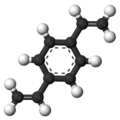Top Qs
Timeline
Chat
Perspective
Divinylbenzene
Organic compound, C₆H₄(CH=CH₂)₂ From Wikipedia, the free encyclopedia
Remove ads
Divinylbenzene (DVB) is an organic compound with the chemical formula C6H4(CH=CH2)2 and structure H2C=CH−C6H4−HC=CH2 (a benzene ring with two vinyl groups as substituents). It is related to styrene (vinylbenzene, C6H5−CH=CH2) by the addition of a second vinyl group.[2] It is a colorless liquid manufactured by the thermal dehydrogenation of isomeric diethylbenzenes. Under synthesis conditions, o-divinylbenzene converts to naphthalene and thus is not a component of the usual mixtures of DVB.[3]
Remove ads
Production and use
It is produced by dehydrogenation of diethylbenzene:
- C6H4(C2H5)2 → C6H4(C2H3)2 + 2 H2
Divinylbenzene is usually encountered as a 2:1 mixture of m- and p-divinylbenzene, containing also the corresponding isomers of ethylvinylbenzene.
Styrene and divinylbenzene react to form the copolymer styrene-divinylbenzene, S-DVB or Sty-DVB. The resulting cross-linked polymer is mainly used for the production of ion exchange resin and Merrifield resins for peptide synthesis.[3]
Remove ads
Nomenclature
- Ortho: variously known as 1,2-diethenylbenzene, 1,2-divinylbenzene, o-vinylstyrene, o-divinylbenzene
- Meta: known as 1,3-diethenylbenzene, 1,3-divinylbenzene, m-vinylstyrene, m-divinylbenzene
- Para: known as 1,4-diethenylbenzene, 1,4-divinylbenzene, p-vinylstyrene, p-divinylbenzene.
These compounds are systematically called diethenylbenzene, although this nomenclature is rarely encountered.
References
Wikiwand - on
Seamless Wikipedia browsing. On steroids.
Remove ads



